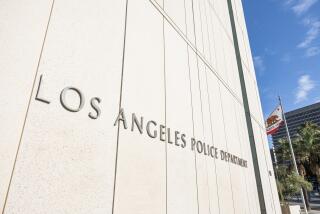The Fight Against Crime: Notes From The Front : LAPD Begins Switch to New Radio System
- Share via
After years of coping with an electronic Tower of Babel, the Los Angeles Police Department has embarked on a plan that will, for the first time, give officers the ability to speak via radio to any other officer in any other agency, division or nearby city.
As it stands now, officers are given a radio with only eight channels. Officers in the same division and those in adjacent areas are often--though not always--given radios with the same channels.
Although it might sound mundane, the channel gap is a serious problem, said Sgt. Kurt Miles, the officer in charge of the radio technology unit.
During a riot, earthquake or any other situation in which officers have been sent to areas outside their usual territory, they often found themselves deaf and mute, in radio terms, unable to communicate with anyone but their compatriots in the home territory, who usually had nothing to do with the problem at hand.
No longer.
The LAPD has ordered 3,000 Motorola Astro Saber radios--at a cost of $7.7 million--that give each officer 250-channel capability. Officers will have access to any of the city government’s allotted 57 channels, with room left over to plug into the frequencies used by other cities, the L.A. County Sheriff’s Department and other law enforcement agencies.
“We look at it from an officers’ safety standpoint,” Miles said. “They can have contact with anybody from any point in the city. It creates a flexibility to pull officers from any section of the city and move them to any area, making them a valuable resource wherever we need them.”
What’s more, one sergeant explained, a particular tactical scene or crime situation can have its own frequency, safe from interruptions at key moments by stray chatter about other events from outside officers.
The radio is a bit smaller than the current models, about half the size of a sheet of notebook paper and an inch thick. Officers carry one on their bodies and one in the car, with the car model having a bit of extra power.
The new radios also are digitized, meaning increased clarity and an end to officers’ fears that their conversations will be monitored by reporters, amateurs with scanners--or, worse yet, the criminals.
“In digital mode, the officers have the capability of talking back and forth in a completely secured environment,” Miles said.
Miles said the department is building a new system to handle the digital communication devices. The new “radio backbone,” will change the whole system used to transmit sounds from one officer to the next.
Digitized radios do not transmit the sound of the voice itself, as current analog radios do, Miles said, but change the voice to a digital signal--such as those by which computers communicate.
The receiving radio translates the digitized signal back into voice sounds.
“It increases clarity, it eliminates a lot of the background noise,” he said. “The filtering device can eliminate a lot of the garbage that floats along with your voice through the airwaves.”
The department has just begun soliciting bids to replace all the radio towers, computers and repeaters (devices that bounce signals over the mountains and around the city) with digital equivalents, Miles said.
Until the system switches over, the officers have been using their new radios in the old-fashioned analog mode.
In the meantime, the department has been handing out the new radios to one division a month; four divisions of the LAPD’s 18 have so far been switched over. Miles said he expects all the units to be handed out by October, 1996.
The Valley’s Van Nuys division received 300 radios about three weeks ago.
“The potential is going to be great,” said Van Nuys Sgt. Alicia Wolin. “It just has broader capabilities. We’re now more in tune with current technology, which makes our jobs a little bit easier.”
Miles said all the feedback his office has gotten has been equally positive.
“They love the capability of being able to talk on so many frequencies,” Miles said.
“They can listen to outside agencies that border their divisions and they are able to talk to any other entity within the Police Department--that has been a giant step.”
More to Read
Sign up for Essential California
The most important California stories and recommendations in your inbox every morning.
You may occasionally receive promotional content from the Los Angeles Times.










